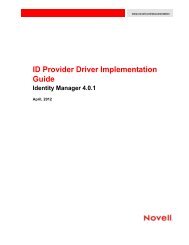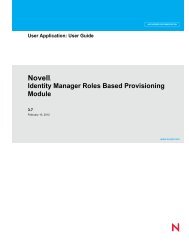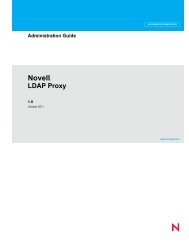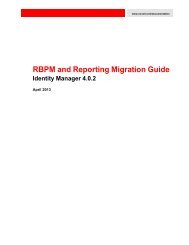Identity Manager 4.0.1 Driver for Scripting Implementation ... - NetIQ
Identity Manager 4.0.1 Driver for Scripting Implementation ... - NetIQ
Identity Manager 4.0.1 Driver for Scripting Implementation ... - NetIQ
You also want an ePaper? Increase the reach of your titles
YUMPU automatically turns print PDFs into web optimized ePapers that Google loves.
To publish or subscribe to additional attributes, you must add them to the filter and add support <strong>for</strong><br />
them into the scripts. Topics in this section include<br />
• Section 5.4.1, “Modifying the Filter,” on page 45<br />
• Section 5.4.2, “Modifying the Scripts <strong>for</strong> New Attributes,” on page 45<br />
5.4.1 Modifying the Filter<br />
1 On the i<strong>Manager</strong> <strong>Driver</strong> Overview page <strong>for</strong> the driver, click the Filter icon on either the<br />
Publisher or Subscriber channel. It is the same object.<br />
2 In the Filter Edit dialog box, click the class containing the attribute to be added.<br />
3 Click Add Attribute, then select the attribute from the list.<br />
4 Select the flow of this attribute <strong>for</strong> the Publisher and Subscriber channels.<br />
• Synchronize: Changes to this object are reported and automatically synchronized.<br />
• Ignore: Changes to this object are not reported and not automatically synchronized.<br />
• Notify: Changes to this object are reported, but not automatically synchronized.<br />
• Reset: Resets the object value to the value specified by the opposite channel. (You can set<br />
this value on either the Publisher or Subscriber channel, but not both.)<br />
5 Click Apply.<br />
6 If you want to map this attribute to an existing attribute in the connected system’s schema,<br />
modify the Schema Mapping policy <strong>for</strong> the driver.<br />
For complete details about managing filters and Schema Mapping policies, see Policies in the<br />
i<strong>Manager</strong> <strong>for</strong> <strong>Identity</strong> <strong>Manager</strong> Guide.<br />
5.4.2 Modifying the Scripts <strong>for</strong> New Attributes<br />
In the Subscriber channel, scripts are called to take the appropriate action <strong>for</strong> each type of event. You<br />
will need to modify the appropriate scripts to read the values from the new attributes.<br />
Publishing additional attributes requires that you act on changes made in the connected system<br />
application. In addition, the schema.def file should be updated with the additional attributes (see<br />
Section 5.2, “The Connected System Schema File,” on page 38).<br />
5.5 UNIX Shell Developer Guide<br />
The <strong>Scripting</strong> driver provides a complete Shell script API <strong>for</strong> interacting with identity management<br />
systems whose tools (including APIs) are available on Linux and UNIX. The <strong>Identity</strong> Vault and<br />
<strong>Identity</strong> <strong>Manager</strong> can run on any supported operating system. <strong>Identity</strong> <strong>Manager</strong> communicates with<br />
the driver on a different system over an encrypted network connection.<br />
Be<strong>for</strong>e beginning script development, review the preceding topics in this section <strong>for</strong> in<strong>for</strong>mation on<br />
defining what data will be synchronized between identity management systems.<br />
With additional development work, the driver can also be customized to support any scripting<br />
language that supports command-line operation.<br />
Customizing the <strong>Scripting</strong> <strong>Driver</strong> 45
















